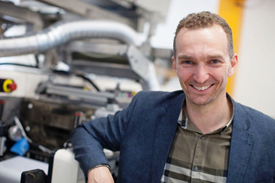2014 Wallenberg Prize Awarded for Electronics on Paper

The 2014 Marcus Wallenberg Prize of SEK 2 million is being awarded to Professor Magnus Berggren at Linköping University, Sweden, for his pioneering research that has made it much easier to print electronics, such as sensors and displays, on paper and cardboard. This opens up a new, huge global market for the forest industry.
Dr. Berggren is being recognized for his contribution to fundamental research and a number of applications of electronics on paper. For example, he has developed ion-based electronic transistors that run at low voltage and are simple to print on relatively raw surfaces like paper.
Using traditional technology, electronics are printed as a thin film of polymer flattened between two electrodes. The printed electronics are also part of the layout on the packaging. Applying voltage to the print releases electrons so that the polymer is given data about the project that can be read or sent to a recipient. The optical properties of the polymer can also be changed so that the ink, for example, changes from transparent to black.
In combination with small batteries and antenna, which also can be printed on paper and cardboard, this breakthrough technology will allow us to connect up to a large number of everyday items around us, and communicate with them.
Simple memories and sensors can be printed cheaply, quickly, and in large quantities. Market assessors believe that the number of items, primarily commercial products, that will be connected to the Internet within 10 years will be approximately 5-10 trillion compared with today’s figure of approximately 15 billion gadgets. Here Dr. Berggren’s work creates a major opening for paper and cardboard, with a new huge global market.
Using the same basic technology, Dr. Berggren has also developed organic bioelectronics—components that enable communication between biological systems (ions) and electronics (electrons)—for use in medicine and diagnostics. They can also be used at home to relieve the health services and, as they are printed on paper, they can be recycled after use.
There are almost endless examples of how electronics printed on paper can change people’s everyday lives The best-before date on the milk carton left out on the table changes. A package from the freezer tells that the content is defrosted. Pick up the muesli packet and receive a warning via a mobile phone that it contains nuts. Check whether a sore throat is caused by bacteria by quickly testing with a simple, cheap, recyclable strip of paper.
Dr. Berggren received his PhD at Linköping University in 1996 and continued his research as a postdoctoral fellow at Bell Labs, in Murray Hill, N.Y., USA. He was one of the driving forces in the establishment of the company Thin Film Electronics AB and was its managing director between 1997 and 1998. Between 1998 and 2002, Dr. Berggren was project leader at the Acreo Swedish ICT and associate professor at Linköping University. Since 2002, he has been Professor in Organic Electronics at Linköping University. heading a group of 35 researchers, at the same time keeping close links to Acreo Swedish ICT. He is involved in a large number of patents and more than 150 articles in well recognized international conference proceedings and scientific journals, among them both Science and Nature.
TAPPI
http://www.tappi.org/
 The 2014 Marcus Wallenberg Prize of SEK 2 million is being awarded to Professor Magnus Berggren at Linköping University, Sweden, for his pioneering research that has made it much easier to print electronics, such as sensors and displays, on paper and cardboard. This opens up a new, huge global market for the forest industry.
The 2014 Marcus Wallenberg Prize of SEK 2 million is being awarded to Professor Magnus Berggren at Linköping University, Sweden, for his pioneering research that has made it much easier to print electronics, such as sensors and displays, on paper and cardboard. This opens up a new, huge global market for the forest industry.